Development of Condition Assessment Index of Ballast Track Using Ground-Penetrating Radar (GPR)
Abstract
1. Introduction
2. Methods and Tools for GPR Survey
2.1. Experimental Setup
2.2. Surveying Equipment
3. Development of the Ballast Condition Scoring Index
3.1. Preprocessing of Collected GPR Signals
- (1)
- Frequency filtering (high-pass and low-pass filter) to remove higher and lower frequency noises.
- -
- High-pass filtering: the cutoff frequency is one-quarter (1/4) of the operating frequency
- -
- Low-pass filtering: the cutoff frequency in seven-fourths (7/4) of the operating frequency
- (2)
- Time zero correction to remove the air ground interface (i.e., the gap between the GPR antenna and the surface of the medium)
- (3)
- Gain: a linear gain function was applied to compensate for the natural attenuation of the signal
- -
- A linear gain function, with a slope ranging from 0.5 to 5%, can be used depending on the attenuation of the signal.
3.2. Dielectric Permittivity Variation
3.3. Boundary Estimation and Variation
3.4. Signal Strength
3.5. Area of the Frequency Spectrum of the Signal
3.6. Ballast Condition Scoring Index (BCSI) vs. the Fouling Level
4. Verification of the Ballast Condition Scoring Index on a High-Speed Railway
5. Conclusions
Author Contributions
Funding
Acknowledgments
Conflicts of Interest
References
- Esveld, C. Modern Railway Track; Digital Edition; MRT-Productions: Zaltbommel, The Netherlands, 2014. [Google Scholar]
- Indraratna, B.; Salim, W.; Rujikiatkamjorn, C. Advanced Rail Geotechnology—Ballasted Track; CRC Press: London, UK, 2011. [Google Scholar]
- Bassey, D.; Ngene, B.; Akinwumi, I.; Akpan, V.; Bamigboye, G. Ballast Contamination Mechanisms: A Criterial Review of Characterisation and Performance Indicators. Infrastructures 2020, 5, 2412–3811. [Google Scholar] [CrossRef]
- Sussmann, T. Source of Ballast Fouling and Influence Considerations for Condition Assessment Criteria. Transp. Res. Rec. J. Transp. Res. Board 2012, 2289, 87–94. [Google Scholar] [CrossRef]
- Smith, M.R.; Collis, L. Railway track ballast. In Aggregates: Sand, Gravel and Crushed Rock Aggregates for Construction Purposes; Geological Society of London: London, UK, 2001; pp. 285–289. [Google Scholar]
- Bold, R.D. Non-Destructive Evaluation of Railway Trackbed Ballast; The University of Edinburgh: Edinburgh, UK, 2011. [Google Scholar]
- Park, B.S.; Choi, Y.T.; Hwang, S.H. Ballasted Track Status Evaluation Based on Apparent Track Stiffness Index. Appl. Sci. 2020, 14, 4729. [Google Scholar] [CrossRef]
- Fontul, S.; Paixão, A.; Solla, M.; Pajewski, L. Railway Track Condition Assessment at Network Level by Frequency Domain Analysis of GPR Data. Remote Sens. 2018, 4, 559. [Google Scholar] [CrossRef]
- Kuttah, D. Determining the resilient modulus of sandy subgrade using cyclic light weight deflectometer test. Transp. Geotech. 2021, 27, 100482. [Google Scholar] [CrossRef]
- Sulewska, M.J.; Bartnik, G. Application of the Light Falling Weight Deflectometer (LFWD) to Test Aggregate Layers on Geosynthetic Base. Procedia Eng. 2017, 189, 221–226. [Google Scholar] [CrossRef]
- Birhane, F.N.; Choi, Y.T.; Lee, S.J. Development of GPR Device and Analysis Method to Detect Thickness of Ballast Layer. J. Korean Soc. Railw. 2020, 23, 269–278. [Google Scholar] [CrossRef]
- Daniels, D.J. Ground Penetrating Radar, 2nd ed.; Institution of Engineering and Technology: London, UK, 2004. [Google Scholar]
- Shao, W.; Bouzerdoum, A.; Phung, S.L.; Su, L.; Indraratna, B.; Rujikiatkamjorn, C. Automatic Classification of Ground-Penetrating-Radar Signals for Railway-Ballast Assessment. IEEE Trans. Geosci. Remote Sens. 2011, 49, 3961–3972. [Google Scholar] [CrossRef]
- Al-Qadi, I.; Xie, W.; Roberts, R. Optimization of antenna configuration in multiple-frequency ground penetrating radar system for railroad substructure assessment. NDT E Int. 2010, 43, 20–28. [Google Scholar] [CrossRef]
- Leng, Z.; Al-Qadi, I. Dielectric Constant Measurement of Railroad Ballast and Application of STFT for GPR Data Analysis. In Non-Destructive Testing in Civil Engineering; Laboratoire central des ponts et chaussées: Nantes, France, 2009. [Google Scholar]
- Anbazhagan, P.; Naresh, P.; Bharatha, T. Identification of type and degree of railway ballast fouling using ground coupled GPR antennas. J. Appl. Geophys. 2016, 126, 183–190. [Google Scholar] [CrossRef]
- De Bold, R.; O’Connor, G.; Morrissey, J.; Forde, M. Benchmarking large scale GPR experiments on railway ballast. Constr. Build. Mater. 2015, 92, 31–42. [Google Scholar] [CrossRef]
- Alani, A.B.; Fabio, T.; Luca, B.C.; Alessandro, C.; Brancadoro, M.G.; Amir, M. Railway ballast condition assessment using ground-penetrating radar—An experimental, numerical simulation and modelling development. Constr. Build. Mater. 2017, 140, 508–520. [Google Scholar]
- De Chiara, F.; Fontul, S.; Fortunato, E. GPR Laboratory Tests For Railways Materials Dielectric Properties Assessment. Remote Sens. 2014, 6, 9712–9728. [Google Scholar] [CrossRef]
- Roberts, R.; Rudy, J.; Al-Qadi, I.; Tutumluer, E.; Boyle, J. Railroad Ballast Fouling Detection Using Ground Penetrating Radar—A New Approach Based on Scattering from Voids. In Proceedings of the 9th European Conference on NDT (ECNDT 2006), Berlin, Germany, 25–29 September 2006. [Google Scholar]
- Silvast, M.; Levomaki, M.; Nurmikolu, A.; Noukka, J. NDT Techniques in Railway Structure Analysis. In Proceedings of the 7th World Congress on Railway Research, Montreal, QC, Canada, 4–8 June 2006. [Google Scholar]
- Selig, T.E.; Waters, M.J. Track Geotechnology and Substructure Management; Thomas Telford Publishing: London, UK, 1994. [Google Scholar]
- Jol, H. Data Processing And Interpretation. In Ground Penetrating Radar: Theory and Application; Elsevier: Amsterdam, The Netherlands, 2009; pp. 405–413. [Google Scholar]
- Kim, J.-H.; Cho, S.-J.; Yi, M.-J. Removal of ringing noise in GPR data by signal processi. Geosci. J. 2007, 11, 75–81. [Google Scholar] [CrossRef]
- Szymczyk, M.; Szymczyk, P. Preprocessing of GPR data. Image Process. Commun. 2013, 18, 83–90. [Google Scholar] [CrossRef][Green Version]
- Sadeghi, J.; Motieyan, M.; Mollazadeh, M.; Yousefi, B.; Zakeri, J. Improvement of railway ballast maintenance approach, incorporating ballast geometry and fouling conditions. J. Appl. Geophys. 2018, 151, 263–273. [Google Scholar] [CrossRef]
- Hugenschmidt, J. Railway track inspection using GPR. J. Appl. Geophys. 2000, 43, 147–155. [Google Scholar] [CrossRef]
- Lai, W.L.; Poon, C.S. GPR data analysis in time-frequency domain. In The Railway Track and Its Long Term Behaviour; Tzanakakis, K., Ed.; Springer: Dordrecht, The Netherlands, 2013; pp. 362–366. [Google Scholar]
- Leucci, G. Ground Penetrating Radar: The Electromagnetic Signal Attenuation and Maximum Penetration Depth. Sch. Res. Exch. 2008, 2008, 1–7. [Google Scholar] [CrossRef]
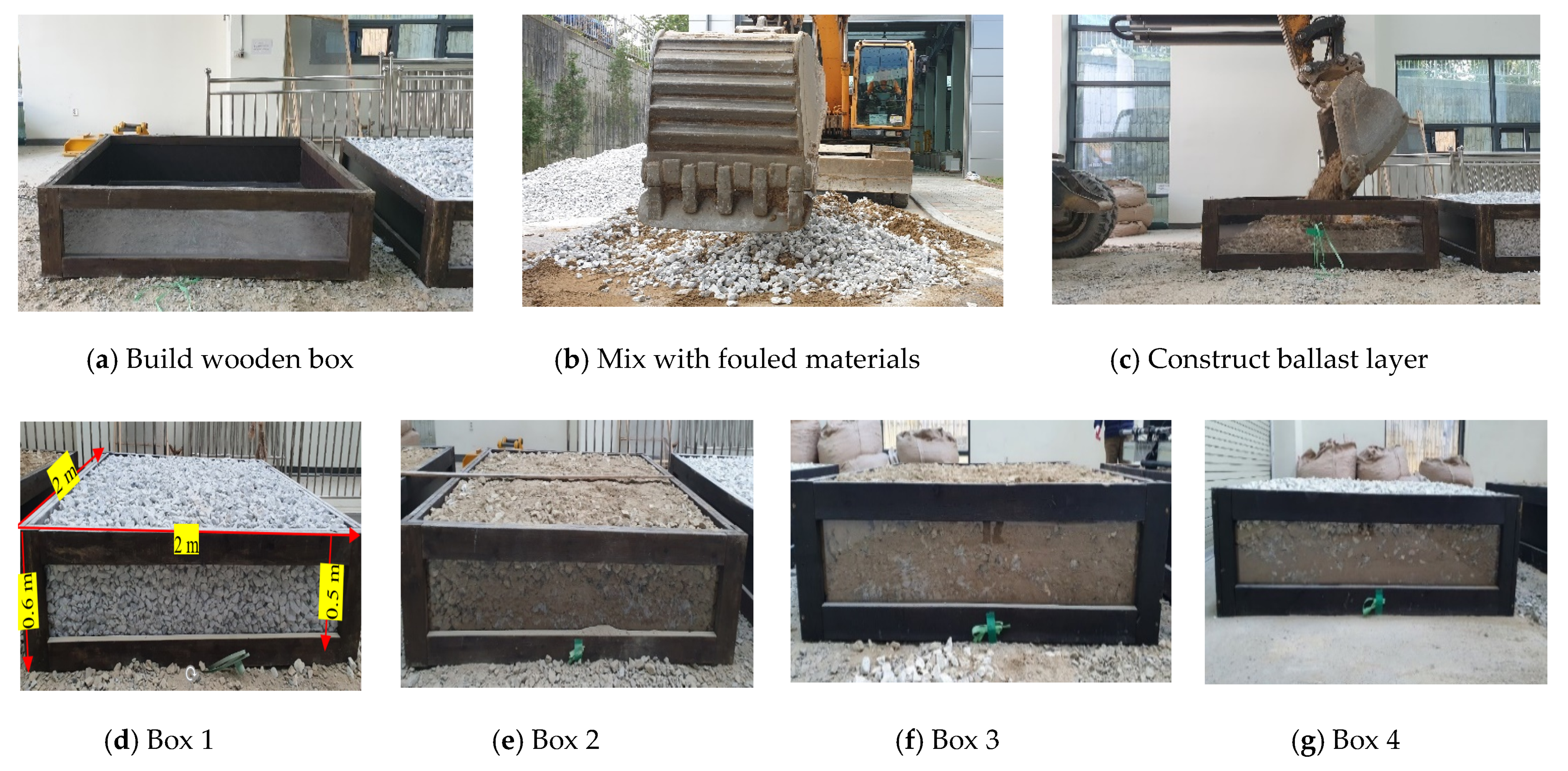




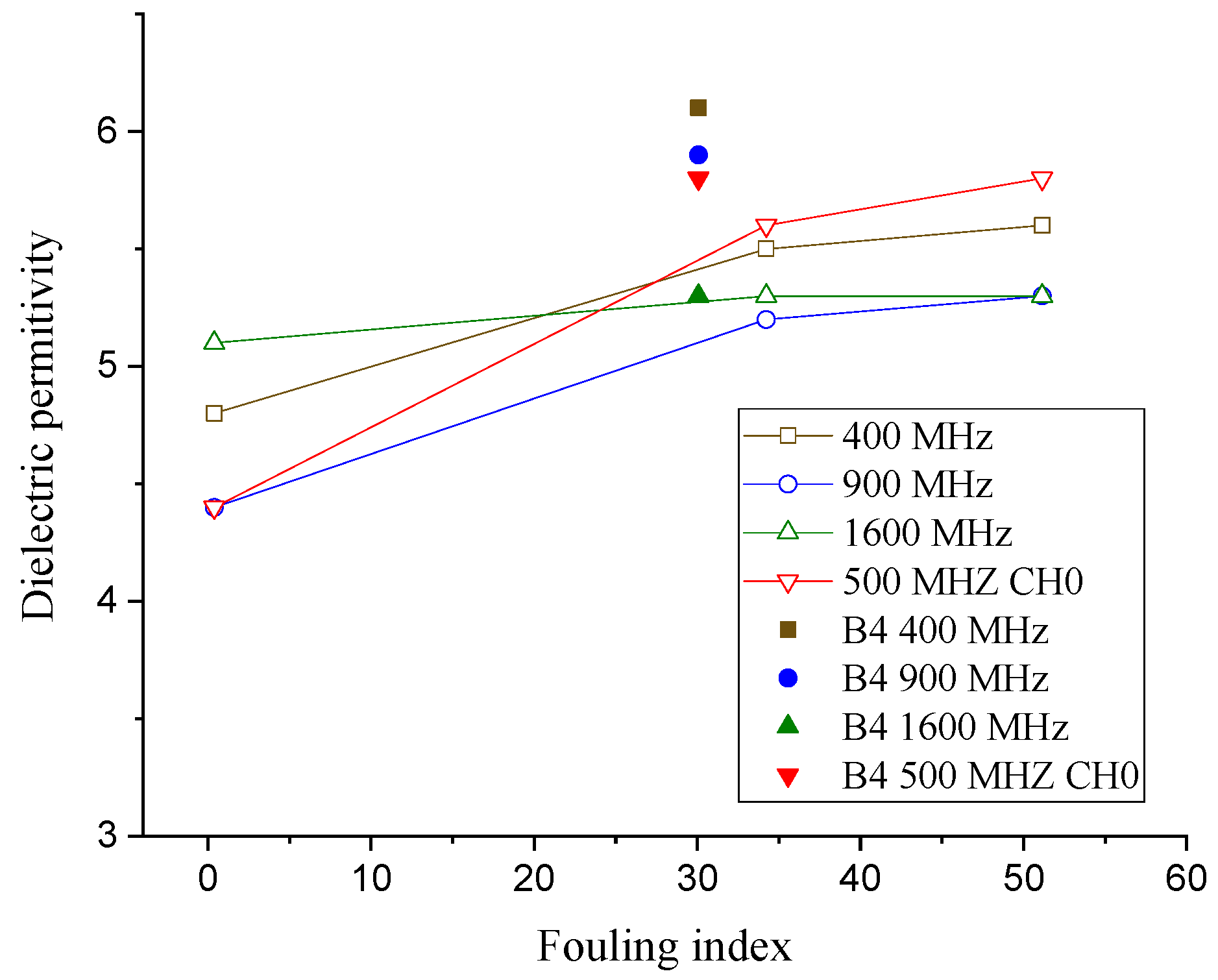

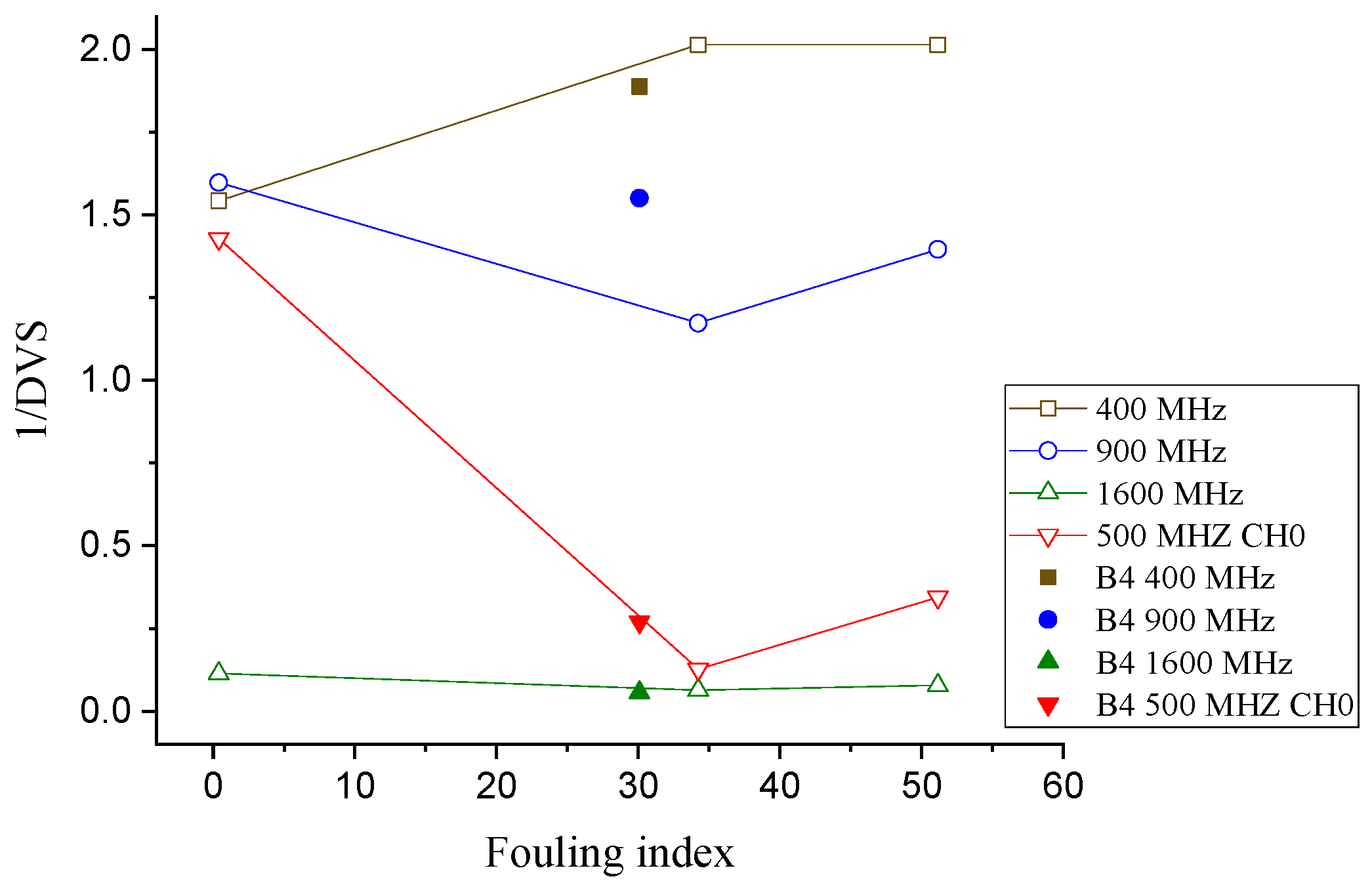
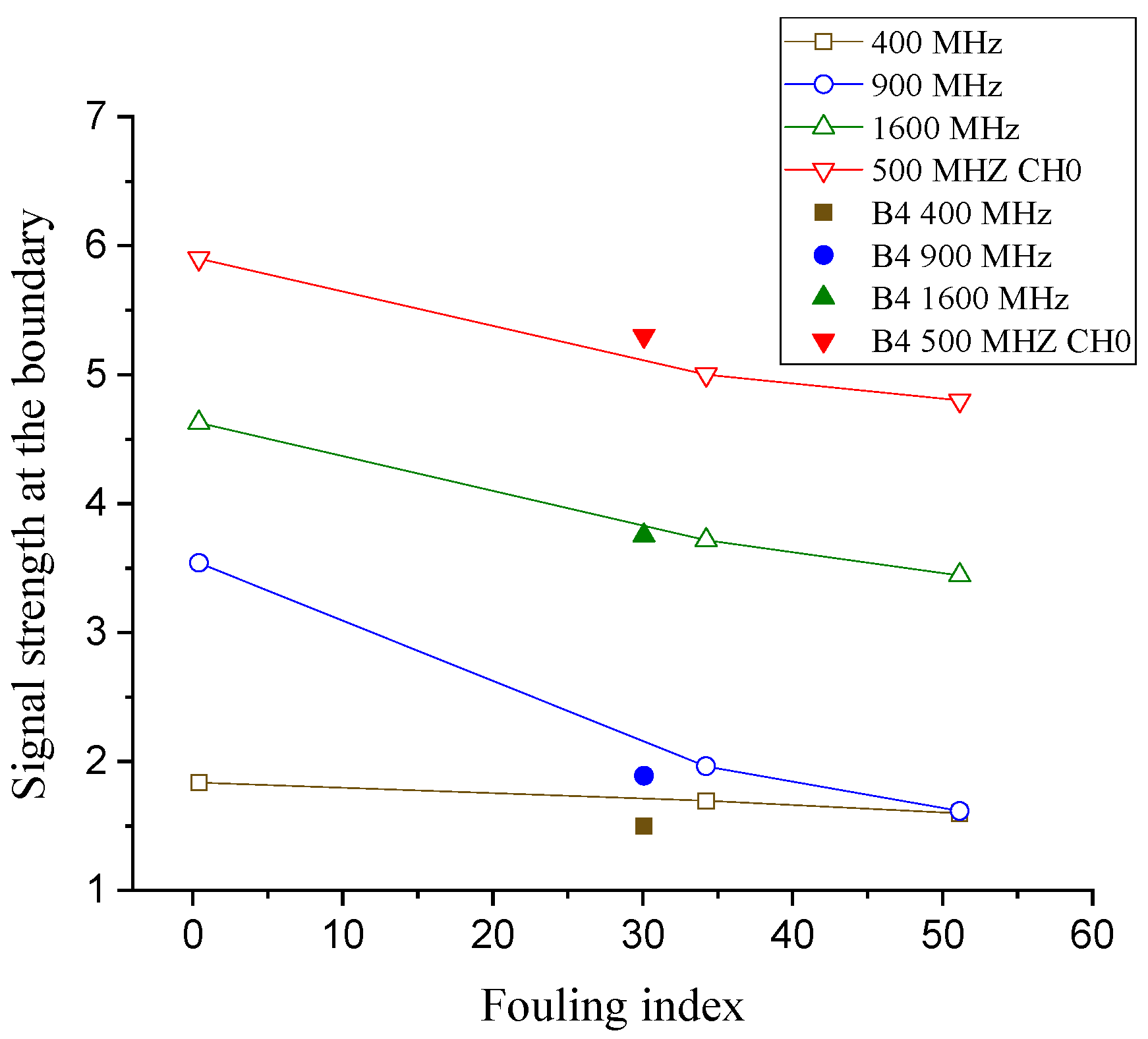

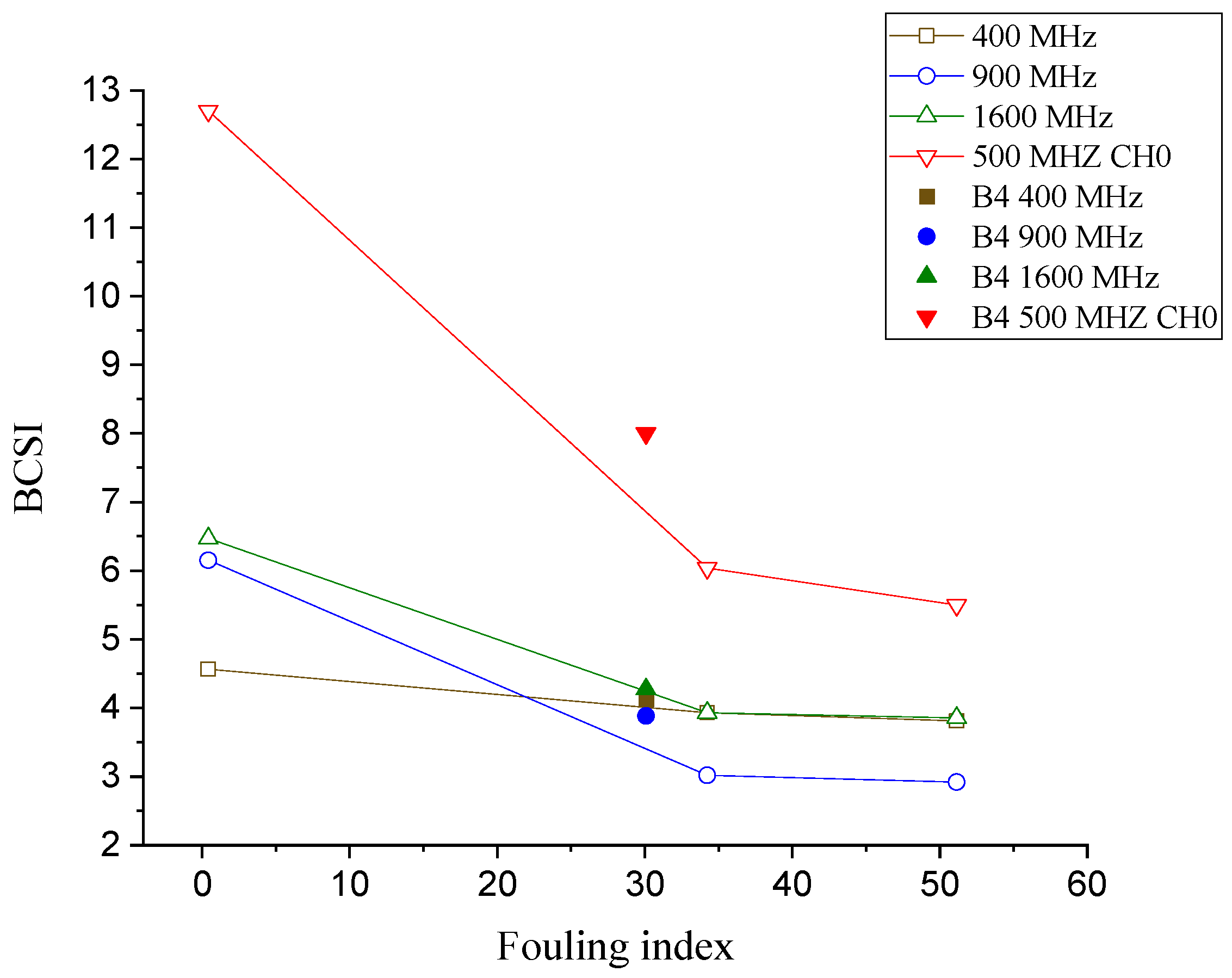


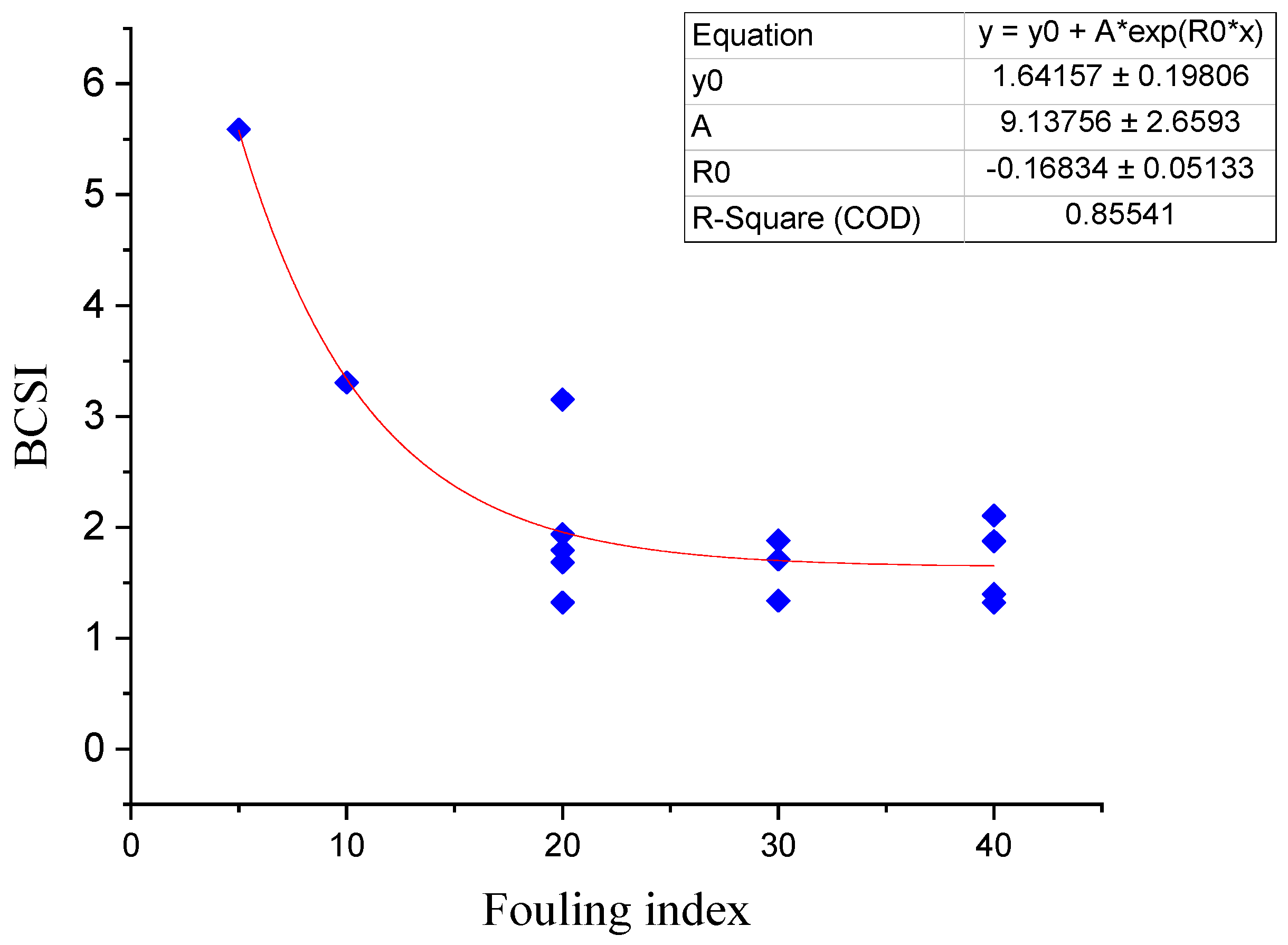
| Box 1 | Box 2 | Box 3 | Box 4 | |
|---|---|---|---|---|
| Ratio of fouling material to clean ballast | 0 | 0.5 | 1.0 | 0–1.0 |
| Fouling index | 0.4 | 34.23 | 51.15 | 30.08 |
| Description | Clean | Partially fouled | Fully fouled | Partially fouled (layer fouled) * 5th (0.00), 4th (0.25), 3rd (0.50), 2nd (0.75), 1st layer (1.00) * |
| Frequency | Adjustment Factor | Remark |
|---|---|---|
| 400 MHz | 15 × 103 | GSSI |
| 900 MHz | 3 × 103 | GSSI |
| 1600 MHz | 6 × 103 | GSSI |
| 500 MHz | 9 × 103 | KRRI |
| Frequency | Adjustment Factor | Remarks |
|---|---|---|
| 400 MHz | 4 × 1010 | GSSI |
| 900 MHz | 2 × 109 | GSSI |
| 1600 MHz | 2 × 1010 | GSSI |
| 500 MHz | 4 × 109 | KRRI |
| Fouling Index 1 | Description of Ballast Condition |
|---|---|
| <1 | Clean |
| 1 to <10 | Moderately clean |
| 10 to <20 | Moderately fouled (Partially fouled) |
| 20 to <40 | Fouled |
| >40 | Highly fouled (Fully fouled) |
| Site | Track | Location | Thickness (cm) | Description of the Fouling Level | Category According to Selig and Waters | Fouling Index (Fi) | |
|---|---|---|---|---|---|---|---|
| Banwall | T1 | 36k260.0 | 53 | Very good condition with slight fouling | Moderately clean | 1 to <10 | 5 |
| 36k294.0 | 48 | Heavy fouling boundary at the bottom | Fouled | 20 to <40 | 30 | ||
| 36k397.0 | 53 | Good to moderate fouling | Moderately clean | 1 to <10 | 10 | ||
| Baebang | T2 | 97k210.0 | >36 | Highly fouled—cannot be hand excavated beyond 36 cm. | Highly fouled | ≥40 | 40 |
| 97k530.0 | >53 | Moisture detected on lower section. | Highly fouled | ≥40 | 40 | ||
| Geomo | T1 | 241k295.0 | 56 | Highly fouled—cannot be excavated beyond 36 cm. | Moderately fouled | 10 to <20 | 20 |
| 241k350.0 | >54 | Lower section has moisture. | Highly fouled | ≥40 | 40 | ||
| 241k370.0 | 56 | Moderate fouling. | Fouled | 20 to <40 | 30 | ||
| 241k460.0 | 69 | Serious fouling. | Moderately fouled | 10 to <20 | 20 | ||
| 241k530.0 | >62 | Cannot be hand excavated beyond 54 cm. | Highly fouled | ≥40 | 40 | ||
| T2 | 241k347.0 | 60 | Fouling moderate-serious. Moisture presence at the bottom section. | Moderately fouled | 10 to <20 | 20 | |
| 241k370.0 | 53 | Moderate fouling | Fouled | 20 to <40 | 30 | ||
| 241k405.0 | >35 | Serious fouling/not to bottom | Moderately fouled | 10 to <20 | 20 | ||
| 241k446.0 | 70 | Moderate fouling | Moderately fouled | 10 to <20 | 20 | ||
Publisher’s Note: MDPI stays neutral with regard to jurisdictional claims in published maps and institutional affiliations. |
© 2021 by the authors. Licensee MDPI, Basel, Switzerland. This article is an open access article distributed under the terms and conditions of the Creative Commons Attribution (CC BY) license (https://creativecommons.org/licenses/by/4.0/).
Share and Cite
Birhane, F.N.; Choi, Y.T.; Lee, S.J. Development of Condition Assessment Index of Ballast Track Using Ground-Penetrating Radar (GPR). Sensors 2021, 21, 6875. https://doi.org/10.3390/s21206875
Birhane FN, Choi YT, Lee SJ. Development of Condition Assessment Index of Ballast Track Using Ground-Penetrating Radar (GPR). Sensors. 2021; 21(20):6875. https://doi.org/10.3390/s21206875
Chicago/Turabian StyleBirhane, Fiseha Nega, Yeong Tae Choi, and Sung Jin Lee. 2021. "Development of Condition Assessment Index of Ballast Track Using Ground-Penetrating Radar (GPR)" Sensors 21, no. 20: 6875. https://doi.org/10.3390/s21206875
APA StyleBirhane, F. N., Choi, Y. T., & Lee, S. J. (2021). Development of Condition Assessment Index of Ballast Track Using Ground-Penetrating Radar (GPR). Sensors, 21(20), 6875. https://doi.org/10.3390/s21206875





